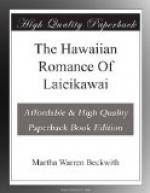This tendency is readily illustrated in the use of synonyms. Oili means “to twist, roll up;” it also means “to be weary, agitated, tossed about in mind.” Hoolala means “to branch out,” as the branches of a tree; it is also applied in sailing to the deflection from a course. Kilohana is the name given to the outside decorated piece of tapa in a skirt of five layers; it means generally, therefore, “the very best” in contrast to that which is inferior. Kuapaa means literally “to harden the back” with oppressive work; it is applied to a breadfruit parched on the tree or to a rock that shows itself above water. Lilolilo means “to spread out, expand as blossom from bud;” it also applies to an open-handed person. Nee may mean “to hitch along from one place to another,” or “to change the mind.” Palele means “separate, put somewhere else when there is no place vacant;” it also applies to stammering. These illustrations gathered almost at random may be indefinitely multiplied. I recall a clergyman in a small hamlet on Hawaii who wished to describe the character of the people of that place. Picking up a stone of very close grain of the kind used for pounding and called alapaa, literally, “close-grained stone,” he explained that because the people of that section were “tight” (stingy) they were called Kaweleau alapaa. This ready imitativeness, often converted into caricature, enters into the minutest detail of life and is the clew to many a familiar proverb like that of the canoe on the coral reef quoted in the text.[3] The chants abound in such symbols. Man is “a long-legged fish” offered to the gods. Ignorance is the “night of the mind.” The cloud hanging over Kaula is a bird which flies before the wind[4]—
The blackbird begged,
The bird of Kaula begged,
Floating up there above Waahila.
The coconut leaves are “the hair of the trees, their long locks.” Kailua district is “a mat spread out narrow and gray.”
The classic example of the use of such metaphor in Hawaiian song is the famous passage in the Hauikalani in which chiefs at war are compared with a cockfight, the favorite Hawaiian pastime[5] being realistically described in allusion to Keoua’s wars on Hawaii:




